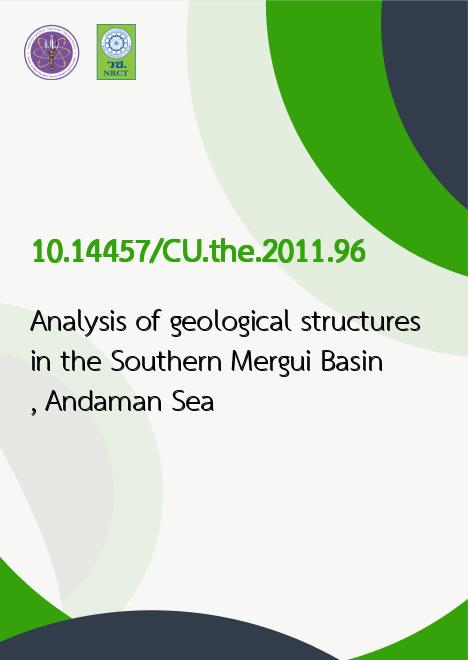
|
Analysis of geological structures in the Southern Mergui Basin, Andaman Sea |
|---|---|
| รหัสดีโอไอ | |
| Title | Analysis of geological structures in the Southern Mergui Basin, Andaman Sea |
| Creator | Niramol Tintorkorn |
| Contributor | Punya Charusiri, Passakorn Pananont |
| Publisher | Chulalongkorn University |
| Publication Year | 2554 |
| Keyword | การสำรวจทางธรณีวิทยา--แอ่งเมอร์กุย, ตะกอน (ธรณีวิทยา), รอยเลื่อน (ธรณีวิทยา)--แอ่งเมอร์กุย, Geological surveys--Mergui Basin, Sediments (Geology), Faults (Geology)--Mergui Basin |
| Abstract | The southern part of the Mergui Basin in the Andaman Sea, offshore Thailand, has been investigated for its structures. Ten 2D-reflection seismic profiles together with previous core–log and stratigraphic data have been applied to indicate the formations and their associated structures.Nine formations and their average thickness have been identified from the seismic data including, Ranong (oldest, 1,400 m.), Yala (1,120 m.), Kantang (1,300 m), Tai (500 m), Payang (600 m.), Surin (600 m.), Trang (700 m.), Thalang (200 m). and Takuapa (youngest, 200 m). Prograding clinoforms observed at eastern edges of the basin suggest deposition onto slopes with the sequences thicken towards the south. Occurrences of onlap and downlap structures of the Takua Pa and Thalang formations suggest the bathy marine transgression and regression, respectively. Two major sets of steep-dipping faults have been recognized, the north-south trending Mergui Fault and the northeast – southwest trending Ranong Fault, both are found to offset the seafloor and the Thalang Formation with the vertical slip of over 30 m. and 40 m, in Eastern Mergui Basin and Ranong Trough. Flower structures detected in seismic data suggest the strike slip movement along with the normal component. The Mergui Fault displays steep dips to the west. Inversion along this fault exhibits very steep dipping to the east and is usually found in older sequences, i.e, Ranong Formation. The different slip movements along these two faults suggest a possible change in depocenters and tectonic regimes through Neogene times. These two faults are still active untill present. The evolution of the southern Mergui Basin commenced with the Late Oligocene rifting, followed by thermal subsidence and developing the large and thick sedimentation through time. |
| URL Website | cuir.car.chula.ac.th |